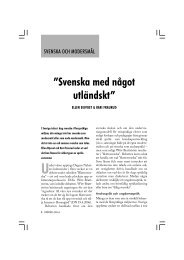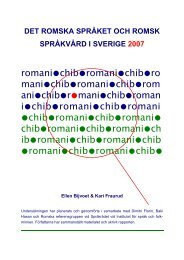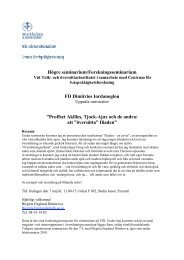Abstracts – NORDAND 11 - Centrum för tvåspråkighetsforskning ...
Abstracts – NORDAND 11 - Centrum för tvåspråkighetsforskning ...
Abstracts – NORDAND 11 - Centrum för tvåspråkighetsforskning ...
You also want an ePaper? Increase the reach of your titles
YUMPU automatically turns print PDFs into web optimized ePapers that Google loves.
<strong>Abstracts</strong> <strong>–</strong> <strong>NORDAND</strong> <strong>11</strong><br />
Plenar<strong>för</strong>edrag<br />
presenterade i den ordning de kommer på konferensen.<br />
Prof. Anne Pitkänen‐Huhta Torsdag, plenar 1, hörsal E10<br />
University of Jyväskylä<br />
First, second, foreign languages <strong>–</strong> or linguistic resources for multilingual<br />
practices?<br />
Modern societies are increasingly characterized by concepts such as mobility, diversity, instability<br />
and individuality. Formerly fairly stable communities of practice take on new forms and<br />
shapes both locally and translocally through new means of communication and participation.<br />
Consequently, due to hybrid and mixed uses and truncated repertoires (Blommaert, 2010),<br />
languages are more aptly characterized as fluid (Pennycook, 2007) rather than fixed. In this talk,<br />
I will draw on two ethnographic data sets to illustrate the complexity of language use and<br />
learning today.<br />
I will firstly show how skillfully and creatively multilingual Sámi children navigate the<br />
complex language situation in the endangered indigenous language context of the North while<br />
engaging in creating new literacy practices by drawing on different linguistic and multimodal<br />
resources of their immediate environment.<br />
With the second set of data, I will discuss the problematic notions of first and foreign<br />
languages by showing how young Finns construct their identities and futures as language learners<br />
and users through their relationship to Finnish and English and through their participation in<br />
real and imagines communities.<br />
This empirical evidence raises a number of questions. Is there a new great divide between<br />
current day language practices and current day language education? Are we still relying on fixed<br />
languages with clear boundaries and identifiable roots in practices of language education and<br />
assessment and in official language policies? Should we teach first, second and foreign<br />
languages or should we provide learners with linguistic resources for multilingual practices?<br />
Prof. Tim McNamara Torsdag, plenar 2, hörsal E10<br />
The University of Melbourne<br />
Language in professional contexts: Who defines the construct?<br />
This paper reports on three recent studies focusing on the construct of communication in workplace<br />
contexts, in two cases in the context of the development of assessments. The studies<br />
involve professional communication in clinical contexts, and in aviation. In each case, the views<br />
of professionals involved in the clinical setting have been the focus of the research.<br />
In the case of medical communication, studies have focused on the evaluation by clinical<br />
supervisors of the success of instances of communication with patients on the one hand, and on<br />
telephone communication with senior doctors in emergency settings on the other.<br />
In the case of aviation communication, the views of pilots and air traffic controllers on<br />
episodes of miscommunication between air traffic controllers and pilots were the focus of the<br />
research.<br />
In each case, challenges to conventional views of second language communication arose.<br />
These challenges involve the way in which non-linguistic professional judgement informs and is<br />
inseparable from the success of the communication; and the shared responsibility for communicative<br />
success between native and non-native speakers. The findings suggest that we need to<br />
radically revise the construct of professional communication in teaching and in assessment.<br />
3





